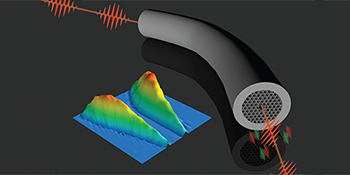
Credit: Martin Finger, Max Planck Institute for the Science of Light
Scientists studying quantum metrology, key distribution and other topics in quantum optics require entangled photon pairs, typically generated through optical fibers. However, these fibers often add noise from spontaneous Raman scattering to the desired twin beams.
A research team based in Germany has shown that a particular kind of photonic crystal fiber filled with argon gas can generate bright twin beams without Raman noise (Phys. Rev. Lett., doi:10.1103/PhysRevLett.115.143602).
The group, led by doctoral student Martin A. Finger of the Max Planck Institute for the Science of Light, chose a 30-cm length of hollow-core fiber with a trihexagonal microstructure known as kagome lattice. The scientists pumped it with 250-kHz pulses from a Ti:sapphire laser operating at 800 nm. The trip through the gas-filled fiber splits the beam into a pair of signals slightly above and below the original frequency, in a process called modulational instability.
The resulting squeezed-vacuum twin beams contained about 2,500 photons per mode—about three times brighter than previous sources of that nature. Each band had a spectral bandwidth of roughly 50 THz.
The researchers found that they could tune the spectral location of the sidebands over a range of approximately 80 THz by varying the argon pressures between 50 to 96 bar, although 76 bar turned out to be the optimum working pressure inside the fiber. The lack of Raman scattering within the fiber is due to the monatomic nature of the argon gas, through which the photons actually propagate.
Scientists from the University of Erlangen-Nuremburg in Germany and the Lomonosov Moscow State University in Russia also contributed to the experiments.
